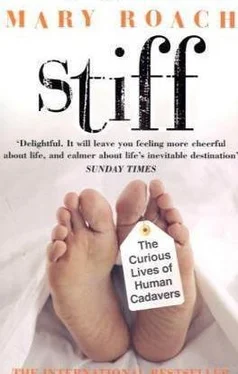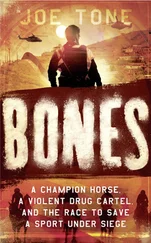Noticeably absent amid the flowers and candles is the casket displaying the deceased. This would have been logistically challenging, as all twenty-some corpses have been reduced to neatly sawed segments—hemisections of pelvis and bisected heads, the secret turnings of their sinus cavities revealed like Ant Farm tunnels. This is a memorial service for the unnamed cadavers of the University of California, San Francisco, Medical School Class of 2004 gross anatomy lab. An open-casket ceremony would not have been especially horrifying for the guests here today, for they have not only seen the deceased in their many and various pieces, but have handled them and are in fact the reason they have been dismembered. They are the anatomy lab students.
This is no token ceremony. It is a sincere and voluntarily attended event, lasting nearly three hours and featuring thirteen student tributes, including an a capella rendition of Green Day’s “Time of Your Life,” the reading of an uncharacteristically downbeat Beatrix Potter tale about a dying badger, and a folk ballad about a woman named Daisy who is reincarnated as a medical student whose gross anatomy cadaver turns out to be himself in a former life, i.e., Daisy. One young woman’s tribute describes unwrapping her cadaver’s hands and being brought up short by the realization that the nails were painted pink. “The pictures in the anatomy atlas did not show nail polish,” she wrote. “Did you choose the color?… Did you think that I would see it?… I wanted to tell you about the inside of your hands… I want you to know you are always there when I see patients. When I palpate an abdomen, yours are the organs I imagine. When I listen to a heart, I recall holding your heart.” It is one of the most touching pieces of writing I’ve ever heard. Others must feel the same; there isn’t an anhydrous lacrimal gland in the house.
Medical schools have gone out of their way in the past decade to foster a respectful attitude toward gross anatomy lab cadavers. UCSF is one of many medical schools that hold memorial services for willed bodies.
Some also invite the cadavers’ families to attend. At UCSF, gross anatomy students must attend a pre-course workshop hosted by students from the prior year, who talk about what it was like to work with the dead and how it made them feel. The respect and gratitude message is liberally imparted. From what I’ve heard, it would be quite difficult, in good conscience, to attend one of these workshops and then proceed to stick a cigarette in your cadaver’s mouth or jump rope with his intestines.
Hugh Patterson, anatomy professor and director of the university’s willed body program, invited me to spend an afternoon at the gross anatomy lab, and I can tell you here and now that either the students were exceptionally well rehearsed for my visit or the program is working.
With no prompting on my part, the students spoke of gratitude and preserving dignity, of having grown attached to their cadavers, of feeling bad about what they had to do to them. “I remember one of my teammates was just hacking him apart, digging something out,” one girl told me, “and I realized I was patting his arm, going, ‘It’s okay, it’s okay.’”
I asked a student named Matthew whether he would miss his cadaver when the course ended, and he replied that it was actually sad when “just part of him left.” (Halfway through the course, the legs are removed and incinerated to reduce the students’ exposure to the chemical preservatives.)
Many of the students gave their cadavers names. “Not like Beef Jerky. Real names,” said one student. He introduced me to Ben the cadaver, who, despite having by then been reduced to a head, lungs, and arms, retained an air of purpose and dignity. When a student moved Ben’s arm, it was picked up, not grabbed, and set down gently, as if Ben were merely sleeping. Matthew went so far as to write to the willed body program office asking for biographical information about his cadaver. “I wanted to personalize it,” he told me.
No one made jokes the afternoon I was there, or anyway not at the corpses’ expense. One woman confessed that her group had passed comment on the “extremely large genitalia” of their cadaver. (What she perhaps didn’t realize is that the embalming fluid pumped into the veins expands the body’s erectile tissues, with the result that male anatomy lab cadavers may be markedly better endowed in death than they were in life.) Even then, reverence, not mockery, colored the remark.
As one former anatomy instructor said to me, “No one’s taking heads home in buckets anymore.”
To understand the cautious respect for the dead that pervades the modern anatomy lab, it helps to understand the extreme lack of it that pervades the field’s history. Few sciences are as rooted in shame, infamy, and bad PR as human anatomy.
The troubles began in Alexandrian Egypt, circa 300 B.C. King Ptolemy I was the first leader to deem it a-okay for medical types to cut open the dead for the purpose of figuring out how bodies work. In part this had to do with Egypt’s long tradition of mummification. Bodies are cut open and organs removed during the mummification process, so these were things the government and the populace were comfortable with. It also had to do with Ptolemy’s extracurricular fascination with dissection. Not only did the king issue a royal decree encouraging physicians to dissect executed criminals, but, come the day, he was over at the anatomy room with his knives and smock, slitting and probing alongside the pros.
Trouble’s name was Herophilus. Dubbed the Father of Anatomy, he was the first physician to dissect human bodies. While Herophilus was indeed a dedicated and tireless man of science, he seems to have lost his bearings somewhere along the way. Enthusiasm got the better of compassion and common sense, and the man took to dissecting live criminals . According to one of his accusers, Tertullian, Herophilus vivisected six hundred prisoners. To be fair, no eyewitness account or papyrus diary entries survive, and one wonders whether professional jealousy played a role.
After all, no one was calling Tertullian the Father of Anatomy.
The tradition of using executed criminals for dissections persisted and hit its stride in eighteenth- and nineteenth-century Britain, when private anatomy schools for medical students began to flourish in the cities of England and Scotland. While the number of schools grew, the number of cadavers stayed roughly the same, and the anatomists faced a chronic shortage of material. Back then no one donated his body to science. The churchgoing masses believed in a literal, corporal rising from the grave, and dissection was thought of as pretty much spoiling your chances of resurrection: Who’s going to open the gates of heaven to some slob with his entrails all hanging out and dripping on the carpeting? From the sixteenth century up until the passage of the Anatomy Act, in 1836, the only cadavers legally available for dissection in Britain were those of executed murderers.
For this reason, anatomists came to occupy the same terrain, in the public’s mind, as executioners. Worse, even, for dissection was thought of, literally, as a punishment worse than death. Indeed, that—not the support and assistance of anatomists—was the authorities’ main intent in making the bodies available for dissection. With so many relatively minor offenses punishable by death, the legal bodies felt the need to tack on added horrors as deterrents against weightier crimes. If you stole a pig, you were hung. If you killed a man, you were hung and then dissected . (In the freshly minted United States of America, the punishable-by-dissection category was extended to include duelists, the death sentence clearly not posing much of a deterrent to the type of fellow who agrees to settle his differences by the dueling pistol.)
Читать дальше












